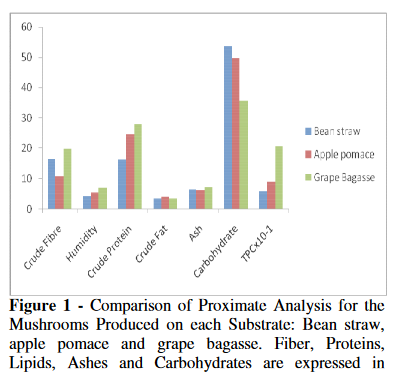Determining the basic composition and total phenolic compounds of Pleurotus sajor-caju cultivated in three different substrates by solid state bioprocess
DOI:
https://doi.org/10.20873/jbb.uft.cemaf.v3n2.pazPalabras clave:
Pleurotus sajor - caju, nutritional composition, oyster mushroom, phenolic compounds, grape bagasse, apple pomaceResumen
Oyster mushrooms (Pleurotus sajor-caju) were grown in grape bagasse, apple pomace or bean straw. Samples were taken for each one of the substrates and analyzed for moisture, ash, carbohydrate, crude fat, crude fiber, crude protein content and total phenolic compounds. The substrate affected all the parameter content and mainly the total phenolic compounds. In general, the nutritional aspects of mushrooms produced using grape bagasse tended to be better. Changes in the total phenolic compound content of the fruit could be explained by the biosorption capacity from substrate. It was possible to confirm that composition depends on cultivation substrate.
Citas
AOAC, (1990), Official Methods of Analysis, 14th ed.; Association of Official Analytical Chemists: Washington, DC.
Asolini, F. C.; Tedesco, A. M.; Carpes, S. T.; Ferraz, C.; Alencar, S. M. (2006), Atividade Antioxidante e Antibacteriana dos Compostos Fenólicos dos Extratos de Plantas Usadas como Chás. Brazilian Journal of Food Technology, 9, 209-215.
Badalyan, S. M. (2003), Edible and Medicinal Higher Basidiomycetes Mushrooms as a Source of Natural Antioxidants. International Journal of Medicinal Mushrooms, 5, 153-163.
Devrajan, A.; Joshil, V. K.; Gupta, K.; Sheikher, C.; Lal, B. B. (2004), Evaluation of Apple Pomace Based Reconstituted Feed in Rats After Solid State Fermentation and Ethanol Recovery. Brazilian Archives of Biology and Technology, 47, 93-106.
Lakshmi, B.; Jose, N.; Ajith, T.; Janardhanan, K. K. (2004), Antimutagenic Activity of Methanolic Extract of Culinary-Medicinal Oyster mushroom, Pleurotus ostreatus (Jacq.:Fr.) Kumm. (strain florida Eger nom. nud.) and Its Protective Effect Against Benzo [a] Pyrene-Induced Hepatic Damages. International Journal of Medicinal Mushrooms, 6, 139-150.
Manzi, P.; Marconi, S.; Guzzi, A.; Pizzoferrato, L. (2004), Commercial mushrooms: nutritional quality and effect of cooking. Food Chemistry, 84, 201-206.
Mattila, P.; Salo-Väänänen, P.; Konko, K.; Aro, H.; Jalava, T. (2002), Basic Composition and Amino Acid Contents of Mushrooms Cultivated in Finland. Journal of Agricultural Food Chemistry, 50, 6419-6422.
Mizuno, T. and Zhuang, C. (1995), Houbitake, Pleurotus sajor-caju: antitumor activity and utilization. Food Review International, 11, 185-187.
Ngai, P. H. K. and Ng, T. B. (2004), A ribonuclease with antimicrobial, antimitogenic and antiproliferative activities from the edible mushroom Pleurotus sajor-caju. Peptides, 25, 11-17.
Paz, M. F.; Vieira, E.; Breyer, C. A.; Giovanni, R. N.; Bertoldi, F. C. (2006), Cultivo de Pleurotus sajor-caju em bagaço de uva Isabel. Evidência, 6, 187-194.
Ramos, A. C.; Sapata, M. M.; Candeias, M.; Figueiredo, E.; Gomes, M. L. (2003), Cultura de Cogumelos do Gênero Pleurotus. Portugal: INIAP, 605-611.
Silva, S. O.; Costa, S. M. G.; Clemente E. (2002), Chemical composition of Pleurotus pulmonarius (Fr.) Quél., substrates and residue after cultivation. Brazilian Archives of Biology and Biotechnology, 45, 531-535.
Tam, S. C.; Yip, K. P.; Fung, K. P.; Chang, S. T. (1986), Hypotensive and renal effects of an extract of the edible mushroom Pleurotus sajor-caju. Life Science, 38, 155-1161.
Tambekar, D. H.; Sonar, T. P.; Khodke, M. V.; Khante, B. S. (2006), The novel antibacterials from two edible mushrooms: Agaricus bisporus and Pleurotus sajor caju. International Journal of Pharmacology, 2, 584-587.
Villas-Bôas, S. G.; Esposito, E.; Mendonça, M. M. (2003), Bioconversion of apple pomace into a nutritionally enriched substrate by Candida utilis and Pleurotus ostreatus. World Journal of Microbiology and Biotechnology, 19, 461-467.
Yang, J. H.; Ching-Lin, H.; Mau, J.-L. (2001), Non-volatile taste components of several commercial mushrooms. Food Chemistry, 72, 465-471.
Ragunathan, R.; Gurusamy, R.; Palaniswamy, M.; Swaminathan, K. (1996), Cultivation of Pleurotus spp. on various agro-residues, Food Chemistry, 55, 139-144.

Descargas
Publicado
Cómo citar
Número
Sección
Licencia
Copyright (c) 2024 - Journal of Biotechnology and Biodiversity

Esta obra está bajo una Licencia Creative Commons Atribución 4.0 Internacional.
Los autores que publican en esta revista aceptan los siguientes términos:
Los autores mantienen los derechos autorales y conceden a la revista el derecho de primera publicación, con el trabajo simultáneamente licenciado bajo la LicenciaCreative Commons Attribution (CC BY 4.0 en el link http://creativecommons.org/licenses/by/4.0/) que permite compartir el trabajo con reconocimiento de la autoría y publicación inicial en esta revista.
Los autores tienen autorización para asumir contratos adicionales separadamente, para distribución no exclusiva de la versión del trabajo publicado en esta revista (ej.: publicar en repositorio institucional o como capítulo de libro), con reconocimiento de autoría y publicación inicial en esta revista.
A los autores se les permite, y son estimulados, a publicar y distribuir su trabajo online (ej.: en repositorios institucionales o en su página personal) en cualquier punto antes o durante el proceso editorial, ya que esto puede generar alteraciones productivas, bien como aumentar el impacto y la citación del trabajo publicado (disponible en El Efecto del Acceso Libre en el link http://opcit.eprints.org/oacitation-biblio.html).


